Neanderthal jewels and fashions (1)
How smart were the Neanderthalers? For decades, it was surmised that our cousins, 20 percent of whose genetic make-up is surviving in the modern European genome, were little more than upright walking mammals. Considering the lack of testimonies to cultural and technological innovations, a higher intelligence was denied them. Whatever progress they accomplished, they would have copied from modern man, when the latter arrived in Europe. So the story went.
Meanwhile, doubts are mounting about this long-held image of our supposedly slow-brained relatives. Over the past decade, in several places once populated by Neanderthals, objects have been found, which were from all likelihood left behind by them. In a recent issue of scientific journal PLoS One an American-Croatian team of scientists around Davorka Radovčič, a curator at Croatia's Natural History Museum is pubishing a study about Neanderthal jewels fashioned out of the talons of white-tailed eagles.

This corroborates other discoveries made in recent years, according to which the Neanderthals wore jewels and body-paint. All these would point to higher levels of consciousness: jewels have communicative functions, for which abstract thought is necessary. The conscious transformation of an object which does not have an obvious use as a tool points to symbolic or aesthetic thought. That the Neandertals nursed the sick and gave burials to the dead, even to stillborns, and even including the use of flowers, has been known for decades. In short: they did have a culture.
The recent discovery of their genes in the modern European genome, leaving no doubt about interbreeding with homo sapiens, gave rise to speculations that they had acquired this culture through contact with the latter, but had not developed it independently. This contact is estimated to have been established in Europe most likely not before 40.000 years – in the Near East, Homo Neandertaliensis and Homo Sapiens may have met somewhat earlier. This time-span matches many of the supposedly artistic artifacts attributed to the Neanderthalers, so that they could indeed be the results of some „copying“ of the newcomers. But the most recent discoveries and studies do not match this time span at all, and Davorka Radovcic's discovery is far older by a long shot - her eagle's tlons jewelry is dated to an age of 130.000 years – and there were certainly no Homo Sapiens around in Croatia at that time.
This set of eight white-tailed eagles' talons is described as a jewel because of the consciously and purposefully added groovings and the very significant traces of wear. Four of the claws display signs of cutmarks, three of them have grooves cut in exactly the same places. And all eight show abrasion traces, and seem almost polished – such that would occur if they had been worn for a long time in the same position over the same surface.
This surface could then have been a chest, or an upper-arm, the scientists surmise – they think that the talons were part of a chain, or of a bracelet. The cuts and grooves indicate the spots where they would have been tied together.
(...)
Frank Patalong, Der Spiegel, (12.03.2015)
Translated and adapted by Anne-Marie de Grazia
Go to original article
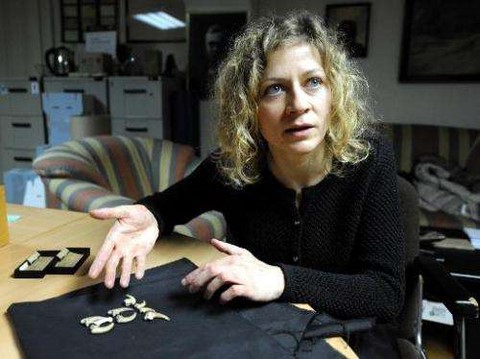
"While reviewing eight, white-tailed eagle talons and an associated phalanx, on the latter I noticed numerous cut marks and a revelation just struck me—they were made by a human hand," Davorka Radovcic told AFP.
The revelation came in late 2013 while reviewing the Krapina Neanderthal collection she had just taken over, items from a site once inhabited by the extinct people in what is modern-day Croatia.
"I knew immediately what might be the implication of that finding," said the anthropologist, carefully holding one of the talons that are kept in a small box.
An international study began with the research published earlier this month by the PLOS peer-reviewed international online scientific publication.
The Krapina site, some 50 kilometres (31 miles) north of Zagreb, has yielded the world's richest collection of Neanderthal fossils. The site containing the remains of some 80 individuals, and including the talons, was discovered in 1899 by Croatian palaeontologist Dragutin Gorjanovic-Kramberger.
But it took 115 years to establish that the talons and phalanx at the Zagreb museum were jewellery, and therefore used for a symbolic purpose.
"I simply had a fresh eye," Radovcic said modestly of her find that for decades had escaped the numerous scientists visiting to study the rich collection.
She initiated the research conducted along with two Croatian colleagues—Ankica Oros Srsen and Jakov Radovcic—as well as anthropology professor David Frayer from the University of Kansas.
The four scientists for months carefully reviewed the specimens that had cut marks, polished facets and abrasions suggesting they had been mounted into jewellery.
They could not determine their symbolic value for Neanderthals or how they wore them, as a necklace or a bracelet. But there is evidence they collected the remains of eagles, as in the Krapina talon assemblage they identified at least three individual birds.
"This is, at least for the time being, the world's earliest jewellery," Radovcic said.
Up until now early jewellery was linked to anatomically modern humans—estimated to be up to 110,000 years old—and consisting of shell beads found at prehistoric sites in Israel.
The researchers also say the Krapina jewellery indicates that contrary to long-held beliefs, Neanderthals possessed the capacity for complex cognitive thinking.
"This is an example of abstract thinking. It proves that Neanderthals possessed a symbolic culture some 80,000 years before the appearance of more modern human forms in Europe," Radovcic emphasised.
Eagles, with a wingspan of more than two meters (seven feet), were among the most impressive flying predators in the Neanderthal environment, and the mighty birds apparently had special value.
"I believe they were admiring eagles .... This jewellery is a message. We don't know what it means, but perhaps they wanted to give themselves the characteristics of an eagle," the young woman said.
Go to full interview

White-tailed eagle, or sea-eagle
A chain made of talons
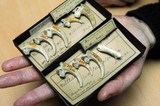
Says the in article in PLOs One:
Four talons bear multiple, edge-smoothed cut marks; eight show polishing facets and/or abrasion. Three of the largest talons have small notches at roughly the same place along the plantar surface, interrupting the proximal margin of the talon blade. These features suggest they were part of a jewelry assemblage, --- the manipulations a consequence of mounting the talons in a necklace or bracelet. An associated phalanx articulates with one of the talons and has numerous cut marks, some of which are smoothed. (...)
Eagle talons are rare at other Neandertal localities and no sites have yielded eight talons from white-tailed eagles or any other raptor. Since three-four different eagles are represented, they must have been acquired in separate events and were preserved as a unit before they were lost in the sediments. Others have noted that raptor bones found in late Pleistocene sites signal some kind of symbolic activity. At Krapina, cut marks on the pedal phalanx and talons are not related to feather removal or subsistence, so these must be the result of severing tendons for talon acquisition. Further evidence for combining these in jewelry is edge smoothing of the cut marks, the small polished facets, medial/lateral sheen and nicks on some specimens. All are a likely manifestation of the separating the bones from the foot and the attachment of the talons to a string or sinew. Cut marks on many aspects, but not the plantar surfaces, illustrate the numerous approaches the Neandertals had for severing the bones and mounting them into a piece of jewelry.
As in ethnohistoric-present societies, the Neandertals’ practice of catching eagles very likely involved planning and ceremony. We cannot know the way they were captured, but if collected from carcasses it must have taken keen eyes to locate the dead birds as rare as they were in the prehistoric avifauna. We suspect that the collection of talons from at least three different white-tailed eagles mitigates against recovering carcasses in the field, but more likely represents evidence for live capture. In any case, these talons provide multiple new lines of evidence for Neandertals’ abilities and cultural sophistication. They are the earliest evidence for jewelry in the European fossil record and demonstrate that Neandertals possessed a symbolic culture long before more modern human forms arrived in Europe.
(...)
Previously, eagle claws have been described as isolated talons at Mousterian sites stretching from about 100 kyr at Pech de l'Azé (France) to older than 44 kyr at Fumane cave (Itale). Other examples of white-tailed eagle bones appear in European Upper Paleolithic and later sites, but they are rare and seldom involve more than one element of the foot. Presence of eight Krapina talons, four showing cut marks, suggests they were disarticulated by cutting the tendons, curated and lost as a unit, probably as a necklace or some other kind of jewelry.
The sandstone rock shelter in NW Croatia was excavated under the direction of Gorjanović-Kramberger between 1899–1905 [19–20]. Today nothing remains of the site except the eroded, sandstone cliff face. But Gorjanović-Kramberger extensively documented the site in his publications and based on the fauna estimated it to be from a warm, interglacial period, now dated to 130,000 years ago or late MIS 5e by ESR and uranium series. According to Miracle this age is concordant with cave bear (Ursus spelaeus) size and morphology. From the earliest to latest deposits the Krapina male cave bears are all small, significantly reduced in size compared to glacial sites in the region with cave bear remains. From this, Miracle suggests the strata at the site were deposited over a warm, short time period, <10,000 years: “The small size of the Krapina male cave bears is best understood as an adaptation to a full interglacial climate … Krapina’s stratigraphy extended neither into later substages of the last interglacial (e.g. MIS 5a-d) nor into the last glacial MIS 3–4”.
The amazingly rich Krapina site
Only evidence of Neandertals is found at Krapina, confirmed by the appearance of Mousterian tools and human remains. Gorjanović-Kramberger and his assistant Osterman collected hundreds of Neandertal bones and teeth, more than 800 stone tools and almost 2800 animal remains. Everything at Krapina derived from excavations in stratified levels and has been curated in the Croatian Natural History Museum (Zagreb) for more than a century. Animal bones as represented by minimum number of individuals (MNI), consist primarily of large mammals, especially rhinos (21.7%), bears (17.0%), and bison/bos (7.5%), while other species like pigs, deer, and small carnivores make up a lesser extent of the fauna. Beavers (Castor fiber) are the exception, mostly coming from the fluvial base of the shelter and constitute 17.9% of the bones from site. A full listing of mammalian fauna includes 25 taxa and of these 13.6% of show evidence of burning and another 4.1% preserve stone tool cut marks [25]. In addition to the mammals, Gorjanović-Kramberger recorded a turtle (Testudo) humerus, fresh water mussel shells of at least three taxa, several taxa of different land snail species and a few bird remains. Except for some of the bird bones, none of the non-mammalian bones or shells shows signs of human manipulation.
Feathers, preferably black
Obviously, the Neandertals had a foible for birds of prey. In 2011, researchers found in a Neanderthal abri in Fumane, Italy 44.000 year-old bones of eagles, falcons and vultures. Besides their belonging to the species of raptors, they share one characteristic: they are unedible.
But the Neanderthaler found something about them which was to their taste, most likely their large pinion feathers which they plucked or cut out in order to wear them as ornaments – and/in order to symbolize rank and power?*

Neanderthal man with feather ornaments, by Mauro Cutrona
We quote here from Life Science:
Neanderthals plucked the feathers from falcons and vultures, perhaps for symbolic value, scientists find.
This new discovery adds to evidence that our closest known extinct relatives were capable of creating art.
Scientists investigated the Grotta di Fumane — "the Grotto of Smoke" — in northern Italy, a site loaded with Neanderthal bones. After digging down to layers that existed at the surface 44,000 years ago, the researchers discovered 660 bones belonging to 22 species of birds, with evidence of cut, peeling and scrape marks from stone tools on the wing bones of birds that had no clear practical or culinary value.
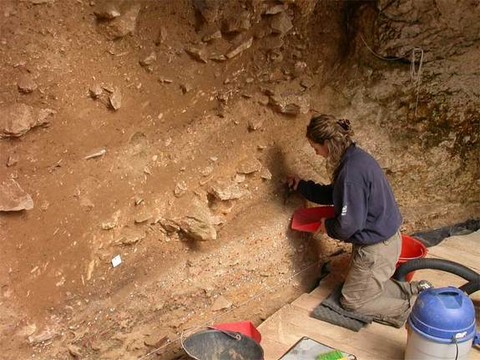
The Grotta di Fumane site, in Northern Italy
"The first traces on the bones of large raptors were found in September 2009," said researcher Marco Peresani, a paleoanthopologist at the University of Ferrara in Italy. "After that, we decided to re-examine the whole bone assemblage recovered from that layer."
These birds included red-footed falcons (Falco vespertinus); bearded lammergeiers (Gypaetus barbatus), a type of vulture; Alpine choughs (Pyrrhocorax graculus), a relative of crows; and common wood pigeons (Columba palumbus). The birds' plumages come in a variety of colors — the gray of the red-footed falcon, the orange-shaded slate gray of the bearded lammergeier, the black of the Alpine chough, and the blue-gray of the common wood pigeon.
"We know that the use of bird feathers was very widespread and that humans have always attributed a broad and complex value to this practice, ranging from social significance and games to the production of ornamental and ceremonial objects," Peresani told LiveScience. "Reconstructing this usually hidden and poorly known aspect among extinct humans is one of the aims of our research."
The scientists detailed their findings online Feb. 21 in the journal Proceedings of the National Academy of Sciences.
Even more recent findings by a team of scientists led by researchers at Gibraltar Museum discovered that the practice was not confined to the small site of Fumane, but wide-spread in space and time all across the Neanderthal world, assorted with an undisputable bias towards black and dark-colored feathers. They examined 1,699 sites across Eurasia containing either the remains of paleontological birds alone, or birds side-by-side with paleolithic Neanderthal remains. There was a clear association between Neanderthal occupation and the remains of raptor and corvid species. And a surprising association between Neanderthal occupation and dark plumaged birds of these species.They reported their findings in PLoS ONE, Sept. 17, 2012.
The team then looked at 604 bird bones from three different Neanderthal sites in Gibraltar (Gorham's Cave, Vanguard Cave and Ibex Cave). Several of the bones showed clear cut-marks made by Neanderthal stone tools, and more than half (337) were wing bones — a finding that the researchers say isn't random.
Wing bones are low in meat compared with other parts of the birds, which suggests the Neanderthals weren't collecting these animals for food, but rather intentionally harvesting them for their feathers
To quote from the article at length:
"... we compiled a database of 1699 Pleistocene Palearctic sites, based on fossil bird sites have been catalogued by Tyrberg. This database included all raptor and corvid species as well as corresponding archaeological and paleontological attribution (...) These results are striking because they show a clear over-representation of bird species with dark remiges (wing feathers) in Palaeolithic sites when compared to paleontological sites with no human presence. It is particularly significant that the relationship holds for two unrelated lineages of birds (families Accipitridae and Corvidae). The relationship was also found to be stronger in the Middle (typical of Neanderthals) than the Upper Palaeolithic.
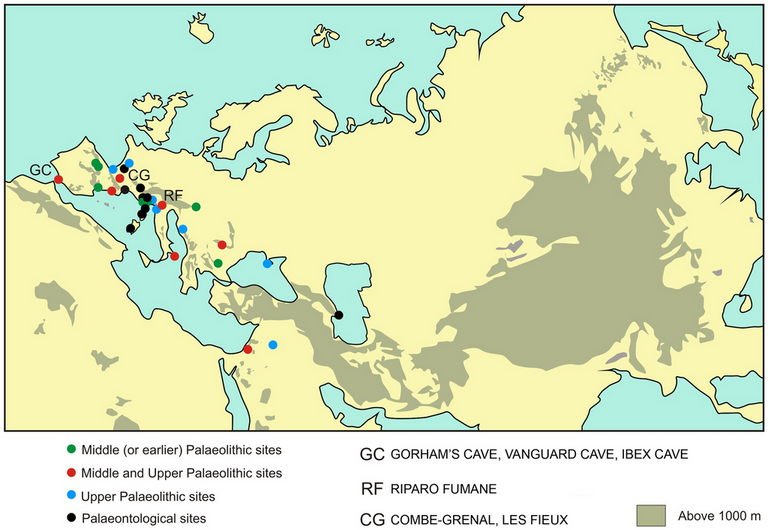
To answer our (...) question, whether the observations from the Gibraltar caves represented a local or geographically wider phenomenon, we returned to the evidence from Riparo Fumane, almost 2000 kilometres from Gibraltar. We have plotted the location of Middle and Upper Palaeolithic and palaeontological sites with at least half of the suite of 18 species identified earlier; we also added Riparo Fumani (with fewer than half of the species). The results show a clear concentration across the western mid-latitude belt, a topographically heterogeneous region well suited for many scavenging raptors and corvids. The similarity between Middle and Upper Palaeolithic sites may indicate behavioural convergence by two hominins within the same region but separated temporally, or they may instead suggest a case of the transmission of a behavioural association from one group to another or even of shared behavioural ancestry. If it was behavioural transmission, then given the temporal precedence of the Neanderthals, it would indicate that the direction of such transmission would have been from Neanderthals to Modern Humans. In any case, the evidence from Gorham's Cave at least, shows that Neanderthals were capable of this behaviour in the absence of Modern Humans.
The strong relationship between Neanderthals, corvids and raptors requires explanation as does the clear evidence of direct action on the bird bones. If this processing of raptors and corvids by Neanderthals had been related to consumption, then we would have expected a concentration of anthropic marks in parts of the anatomy linked to the fleshy regions of the body (e.g. the sternum which holds the large pectoral muscles). Instead, it is the wing bones, low in meat but anchors for the large flight feathers, which were processed. The overrepresentation of raptor and corvid wing bones in Neanderthal sites cannot thus be interpreted in any way other than the use of their feathers. This is supported by the statistically significantly high proportion of individual wing bones and the fact that these had a statistically significant higher frequency of anthropic marks than other bones. Within the wing bones, humeri and ulnae – bones that support the large flight feathers - appeared to have the highest frequency of anthropic marks. The carpo-metacarpi - also supporting flight feathers - might not, we suspect, require as much processing because of their small size, and this may explain the relatively low proportion with anthropic marks. Support that the processing by Neanderthals involved feather removal, and not food, comes from the observation that raptors and corvids are not regularly eaten in any culture, confirmed by the lack of data of corvid or raptor consumption in the ethnographic literature. Feathers as such are not edible either, and they are rapidly disintegrated by feather-degrading bacteria in the soil; thus their use for bedding on cave floors is precluded. The most parsimonious explanation for feather use by Neanderthals would be the same as for tribal Modern Humans: ornaments on their heads and bodies.
Why were dark raptor and corvid feathers selected preferentially over others? These bird species are related to rocky outcrops for nesting and roosting and savannah-like habitats for foraging. They would have therefore been familiar to the Neanderthals and a part of their daily lives; opportunities for obtaining feathers from live birds, at nests or roosts, or from individuals that died and fell to the ground would have been plentiful. They may even have shared the same food resources, as both humans and these scavengers would have coincided around ungulate carcasses. These birds may well have acted as indicators of freshly dead animals to the Neanderthals. Carcasses would have become focal points of convergence for large numbers of vultures, other raptors and corvids, as they still do today. These would have been ideal conditions allowing the Neanderthals the possibility, which would have necessitated a degree of planning and anticipation, of capturing the large birds as they gorged themselves. The behaviour might therefore have originated in the practice of following large birds to fresh carcasses for food. The apparent selection for feathers of specific color, that our results show, adds yet another dimension, requiring sophisticated cognitive processes, to the demonstrated non-random use of feathers.
Lacking previous examples of feather use by Neanderthals, except the valuable recent suggestions by Peresani et al., we have reviewed use of feathers by the only surviving Homo species Modern Humans, H. sapiens. Current or historic use of feathers by Modern Humans is widespread and spans practically every culture that has been studied, including modern western civilization as well as numerous tribal peoples in every permanently inhabited continent. This pattern of feather use for adornment appears to be part of the universal human psyche. The Neanderthals clearly shared this invariant behaviour with Modern Humans, suggesting that it may have been a common characteristic of the two lineages, although we cannot determine if one learnt the behaviour from the other or if it was, instead, present in the common ancestor.
Focusing on tribal examples, and assuming they may represent ancestral traditions, we observe that in a majority of cases the use of feathers is ornamental, in the form of headdresses, cloth decorations, as in skirts or belts, or even full feather cloaks or capes, as those worn by Hawaiian or Maori chiefs. A common characteristic of ornamentation, of which jewellery is the best example, tends to require valuable items that are not easy to replace. Feathers as ornaments seem to follow this rule, common to any biological signal, that is, they are costly to produce or to maintain. The bird species used by humans, such as the Golden Eagle Aquila chrysaetos in the case of the Amerindians, were either scarce in the environment or many individuals were needed to produce the elaborate feathered ornaments, as was the case for the red and yellow birds used in Hawaiian capes, in which thousands of individuals were killed to make a single garment.
The use of feathers, or the application of other species trophies as adornment on the body, is an exclusively human trait. (...)
The results presented here show that extraction of feathers from birds by Neanderthals was a temporally and geographically widespread phenomenon. The results are reinforced by evidence of repetition of this behaviour across a substantial time period of thousands of years in Gibraltar. The earliest observation of this behaviour in Gibraltar preceded the arrival of Modern Humans in Europe by several thousand years. There is therefore no possibility that the practice was acquired from Modern Humans. Thus Neanderthals, though different in a number of ways from Modern Humans had comparable cognitive capacities that included symbolic expression. The observed behavioural differences between them therefore have to be related to distinct cultural trajectories, as would have been the case between different Modern Human populations.
We have shown that Neanderthals were associated with raptors and corvids of particular characteristics (dark remiges, scavenging or colonial cliff nesters) across the entire geographical space of the Palearctic and they directly processed their bones for their feathers. In this respect they were distinctly human. The absence of parietal art in caves occupied by Neanderthals, and also of bone and shell ornaments, is a key argument cited in support of the superior cognitive capacities of Modern Humans. Our results put this long-standing contention in doubt, by providing strong evidence that Neanderthals simply used media, other than cave walls, to express themselves.
Neanderthal jewels and fashions (2)
To make-up, to engrave, to paint
Feather adornments, however, are not the earliest cases of ornamentation in humans. For Modern Humans, ochre pigment use has been suggested as the first manifestation of symbolic behaviour, in South Africa over 160 thousand years ago; it has been heralded as evidence of the transition to “modernity” in humans. Recently, similar evidence of pigment use has been found in the case of early Neanderthals at Maastricht-Belvédère, Netherland. With more recent chronologies, the use of manganese and iron oxides by Late Pleistocene Neanderthals seem to be documented from at least 60,000 years onward.
Dyed shells

A team of researchers around Joao Zilhao of the University of Bristol, UK, discovered in the cave of Aviones, close to the Spanish Mediterranean coast, many heart- and other sea shells, four to nine centimeters in size, and pierced. On these, they found traces of reddish and yellow pigments which were taken from a deposit located 7 kilometers away. One scallop, dyed orange with a mineral dye, was found in the cave of Cueva Antòn, 60 kilometers inland. The respective layers of the finds can be attributed securely an age of 50.000 years, Zilhao‘s team writes in the Proceedings of the National Academy of Sciences.
The Spanish Neanderthalers evidently produced the dyes out of red and yellow pigments, which they must have collected intentionally. One especially aesthetic container used a colored spondylus gaederopus shell, of a kind which, much later, during the late Stone Age, would have a widespread use as a means of payment. Already Neanderthals seem to have been attracted to their many colors and ribbed surfaces. Scientists surmise that dye which they contained were used for possibly large body paintings.
Two sites of the Neandertal-associated Middle Paleolithic of Iberia, dated to as early as approximately 50,000 years ago, yielded perforated and pigment-stained marine shells. At Cueva de los Aviones, three umbo-perforated valves of Acanthocardia and Glycymeris were found alongside lumps of yellow and red colorants, and residues preserved inside a Spondylus shell consist of a red lepidocrocite base mixed with ground, dark red-to-black fragments of hematite and pyrite. A perforated Pecten shell, painted on its external, white side with an orange mix of goethite and hematite, was abandoned after breakage at Cueva Antón, 60 km inland. Comparable early modern human-associated material from Africa and the Near East is widely accepted as evidence for body ornamentation, implying behavioral modernity. The Iberian finds show that European Neandertals were no different from coeval Africans in this regard, countering genetic/cognitive explanations for the emergence of symbolism and strengthening demographic/social ones.
(article in PNAS)
In the cave of Aviones, the scientific team also uncovered remains of sea-snails and red seaweed. They are speculating that Neanderthals may have already mastered the way to transport the easily spoiling mollusks over greater distances, by packing them into wet seaweed-wrapings. At the time, 50,000 years ago, the level of Mediterranean would have been 50 to 90 meters below the present one, which would have put the coast line at a distance of 1,7 to 7 kilometer from the Cueva de los Aviones.
A little fossil pendant
One Neandertaler, who lived some 45.000 years ago in Italy – just fell in love with a snail shell which she or he colored red and hung probably on n animal sinew. This find was judged especially sensational, for the snail shell was by no means fresh when it was picked up one hundred kilometers away from the cave where it was found: the snail shell is a petrified fossil, several million years old.
There was clearly nothing useful about it – but the finder must have found it to be beautiful, unusual, magical or special for whatever reason.
The snail shell caught the attention of a team of scientists around Marco Peresani of the University of Ferrara because it didn’t fit into any picture they knew. The shell of the tiny Aspa marginata was a fossil from the Miocene or the Pliocene: it could be anywhere between 2.5 and 23 million years old. The rock-formation containing the Fumane Cave (see above) dates back to the early Jurassic and is some 200 million years older.
But the Neanderthal would not have found the fossil anywhere near to the cave, Peresani and his colleagues write in the magazine PLoS One. The closest deposits of Miocene or Pliocene Aspa marginata are to be found over 100 kilometers farther, one in the South of the Po Valley, the other in the Prealps of Lombardy.
The layer in which the snail shell was found constituted ca 47.600 to 45.000 years ago the floor of the Fumane Cave. The finds in this layer belong to the epoch called Mousterian – the age of the Neanderthals. Modern humans had not yet reached Northern Italy. It must have been a Neanderthal who found this snail shell so meaningful that he carried it with him over 100 kilometers.
Under the microscope, the snail shell revealed itself to be most interesting. Especially one spot at the inside edge drew the attention of the scientists. They found fine lines, between one and ten microns wide, which were perpendicular to the axis of the shell, and therefore could not have been the result of natural growth. These traces pointed, according to the investigators, „to a prolonged rubbing such as could be caused by a tie with an uneven surface, such as for instance an animal sinew."
And on the outside of the shell they found something else which should not have been there: red paint. It still adhered in tiny pores and rilles of the shell. But it was not evenly distributed. Some spots on the surface seemed to be lightly polished. Less dye was found there. And there was none at all inside the shell.
Under the electronic microscope, things became even more evident. At the edges of the pores, broken crystalline structures were found, which under X-ray spectroscopy were found to be calcium carbonate – that is, they originated from the shell itself. "This pattern makes one surmise that the filling was pushed forcefully into the pores and broke off crystals of calcium carbonate in the process,“ the scientists write. Someone evidently rubbed the pigment with force into the surface of the snail shell. The pigments were made of iron oxyde, which a Raman-spectroscopy identified more precisely as hematite.
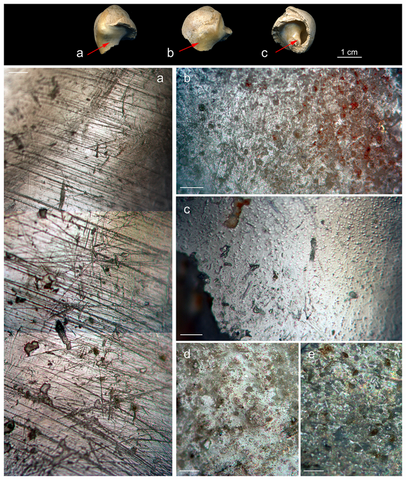
Above, location of the micrographs (a–c) taken on the Fumane Aspa marginata; d-e: inner lips of two Aspa marginata from Pliocene deposits close to Asti, Piemonte region. Notice in b the palympsest of striations present on the inner lip of the archaeological specimen. Scales = 100 µm.
So what was story does the snail shell tell us? To begin with, a Neanderthal picked it up more than 100 kilometers away from the cave. „Then the shell was rubbed with a pure, finely ground powder of hematite, which was probably mixed with some liquid,“ the archaeologists say. "Then it was probably pierced and worn as a personal ornament, before someone in the cave, some 47.600 to 45.000 years ago, discarded it, lost it or laid it down intentionally. "
This discovery is a further proof that the Neanderthals used symbolic objects as an element in their culture: „Future finds will only bring further proof that the Neanderthals had a lot in common with us."
Go to the full article in pdf
Hands on walls
It is disputed, though, that the parietal painting discovered in 2012 in the cave of Puento Viesgo in Northern Spain were made by Neanderthals. The oldest of them date back to 40.000 years ago and are considered to be the oldest cave paintings in Europe – still, it seems likely that the Neandertals may have participated in the first artistic transformation of the cave. Latter, more complex representations of animals are attributed to Homo Sapiens with greater likelihood, but it’s not that sure either.
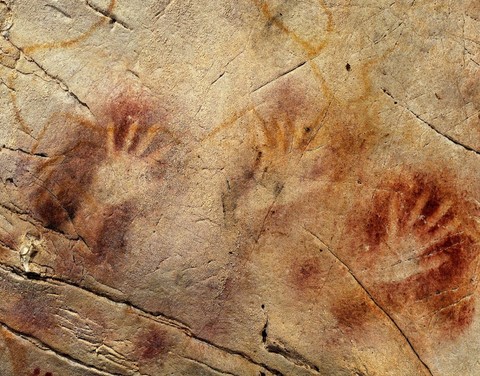
The red hand imprints on the rock wall look like greetings from the last Ice Age: in caves near Puente Viesgo on the Nothern coast of Spain, scientists claim to have discovered proof that the painting of cave walls in Europe began as early as 40,000 years ago.
It means that modern humans would have started painting caves as soon as they arrived from Africa. The other explanation for these sensational finds in Northern Spain would be that they were the work of Neanderthals.
The paintings must have been made just at the time when the settlement of Western Europe by Homo Sapiens had begun, according to the team around the archaeologist and anthropologist Alistair Pike from the University of Bristol. Which would bring one to conclude that cave painting already belonged to the cultural acquisitions of Homo Sapiens before the settlement of Europe, they write in the magazine Science.
Yet it cannot be excluded entirely that the Neanderthals, who lived in Northern Spain when the Homo sapiens arrived, might have participated in some way in the creation of the paintings.
Researchers examined parietal paintings in eleven caves on the Atlantic Coast of Northern Spain. In order to find out when the paintings had been made, they investigated with the help of radioactive substances the age of the calcium deposits which had formed at the surface of the paintings.
In the case of one red disk shape, it turned out that the overlaying calcium layer was 40,800 years old. Which means that this must also be the minimum age of the painting, as the calcium could only have deposited after the painting's execution. In neighboring caves, the archaeologists found art work in which the prehistoric artists had left impressions of their hands. These are over 37,300 years old.
That these artists might have been Neanderthals appears possible: "There is a considerable possibility that they may have done it," according to Joao Zilhao, of the University of Barcelona, who co-authors the study. It is known that the Neanderthals beautified their bodies with primitive techniques and put together pendants made of bones and shells," he argues. "It would not come as a surprise therefore if the Neanderthals had also been Europe’s first rock painters.“
A criss-cross rock-engraving in Gilbratar
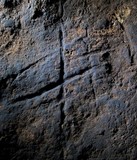
The rock engravings which were found near Gilbraltar in 2014 are no less mysterious: they are 39,000 years old, they are definitely considered to be the work of Neanderthals and can be described as crosslike symbols. They were painstakingly engraved on a flat rock some 40 centimeters high. Optically, they evoke a game of tic Tic-Tac-Toe – now really, they couldn't have been that smart, could they?
With articles translated and adapted by Anne-Marie de Grazia
Der Spiegel, 12.01 2010
*

